Introduction
The Discus range of gliders were produced by the German Aircraft
manufacturing company Schempp-Hirth. They were produced between
1984
and 1995, however some are still produced in the Czech Republic.
Approximately 850 Discus gliders have been produced to this day.
The Discus range features a variety of gliding Aircraft, some
being pure gliders (such as the A or B Model) and others (such
as the BT Model) being gliders with retractable Engines
included.
Discus gliders have won many gliding competitions all over the
world for decades, and still remain very popular with clubs due
to their usability, great performance and reliability.
Aerosoft's Package -
Concept
Aerosoft started designing a product package featuring Discus
gliders way back in 2007. Aerosoft stated they wished to produce
the first ever high-end (therefore complex and system intensive)
glider add-on for FSX.

Picture ©
Aersoft Gmbh
Since they started, Aerosoft have scrapped and re-begun the
project three times, purely because they had not got the result
they had wanted, the product was finally completed and released in early
September 2009.
Purchasing
The product can be purchased in either download or boxed form.
The product costs 27.95 Euros or 29.99 Euros respectively (VAT
Included). One can buy this product from
Aerosoft's Online
store![]() .
.
If you choose the download option, you will be given a download
link along with an unlock code. If you choose the boxed option,
your product should be shipped within a few days (please note
you must pay for shipping).
System Requirements
The requirements of this add-on are fairly normal. You'll need
at least a dual core processor, 2GB RAM, 512MB Graphics Card.
All the usual things. If you can run, lets say, one of
Carenado's Aircraft with no problems then you should be able to
use the Discus Glider X add-on perfectly.
You'll also need FSX with either SP2 or Acceleration Pack
installed.
Installation
Installation is all fairly simple. Just put the CD in/run the
installer gained from your download and you're away. You'll be
asked for your unlock code, and once this is entered
installation will begin.
Once complete, the installer will close and you are ready to
fire up FSX.
Upon starting FSX, you'll be asked the usual “accept this
add-on” message three times. Once these have been acknowledged,
they should never appear again.
Once all this is done, installation of the product is complete.
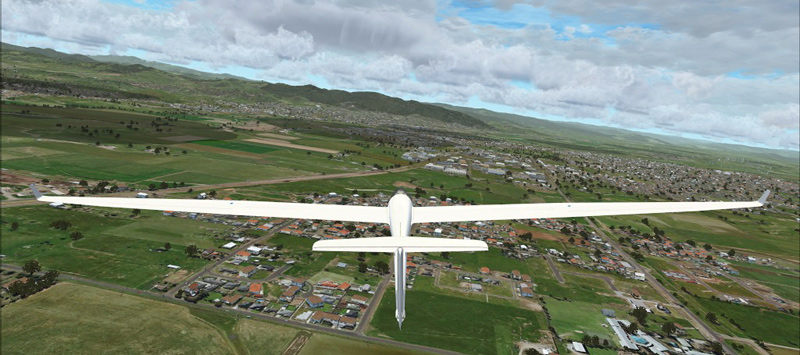
Product
Overview
What You Get
Aerosoft have modelled the B, BT and BM models from
Schempp-Hirth's Discus Glider range. The B and BT models are
fairly common, however the
BM is extremely rare and there are only about 9 of these in the
entire world.
The B model is a pure glider, the BT model is a glider with an
auxiliary engine attached and the BM model is a glider with a
powerful engine attached, allowing for a self-launch.
In the package, there are 5 liveries of the B model, 5 liveries
of the BT model and 3 liveries of the BM model.
Included are models with both German and English tail-numbers
and cockpits.
Detail Level
Aerosoft have designed this product to be absolutely fully
system intensive. This means that they have crammed as much
detail as possible into the product, weather that be visuals,
systems, flight dynamics... The lot.
For example, the virtual cockpit of the BT model has 146384
polygons (quote taken from Aerosoft's website). This is an
incredible level of detail which allows for nothing to be
missed.
Configuration
Once everything has been installed, it's almost time to Fly.
First however you must do a few things to get the most out of
the product.
Setting up Flight Dynamics in FSX
Aerosoft have provided a guide in order to set up the flight
dynamics as best as possible. Once these settings have been
applied, you're one step closer to Flying the Discus.
WinchX
When Aerosoft started the project, they had one massive problem.
Regardless of anything, FSX will not allow the Aero towing of
anything with
an Engine. This means that the BT and BM models would have been
impossible to launch without the aid of an engine (in fact, the
BT model
cannot take off on its own engine anyway).
Luckily, a product was released during the development of this
add-on which allowed Aerosoft to circumvent this problem.
WinchX, a free-ware program made by Peter Lürkens, allows the
(very) realistic Winch launching of Aircraft within FSX.
Aerosoft managed to get a commercial license to include WinchX
in the installation of the Discus Glider X package.
With WinchX installed, all models included in the Discus Glider
package can be launched, one way or another.
WinchX will start up once FSX has been booted, and will appear
as a separate program tab.

CumulusX and
SimProbe
Cumulus X is a program essential for gliding in
FSX. CumulusX allows very realistic formations of thermals over
land and
underneath certain clouds. Cumulus v1.5 now has made SimProbe
unnecessary as Cumulus X also creates very
realistic ridge lift and thermal activity.
Whilst these programs aren't essential to run the add-on, they
are essential to get the most realistic experience of gliding in
FSX. CumulusX also includes a very realistic Thermal Engine
which completely takes over the job of the default engine.
Both programs can be downloaded for free, CumulusX is made by Peter Lürkens and SimProbe
by
is made by Ian Lewis are both
contained within the same download package.
NOTE: All information/download links to these programs will be
listed at the bottom of this Review.
Once all of these programs have been successfully installed,
you're ready to fly the Discus Gliders.
The Gliders – Inside the Cockpit (First Impressions)
Once you hit the Fly Now! Button, you'll be represented with a
beautiful HD rendition of a Discus Glider Cockpit (depending on
which model you chose).
In the cockpit (this model ONLY has a virtual cockpit – No 2D
panel is included), you will notice a few things, such as an
extremely annoying
beeping noise which you'll soon learn is your lifeline in the
air.
The cockpit is surrounded by a panoramic, clear canopy which
allows a great view of the surrounding scenery. Aerosoft have
represented this feeling of freedom of view perfectly.
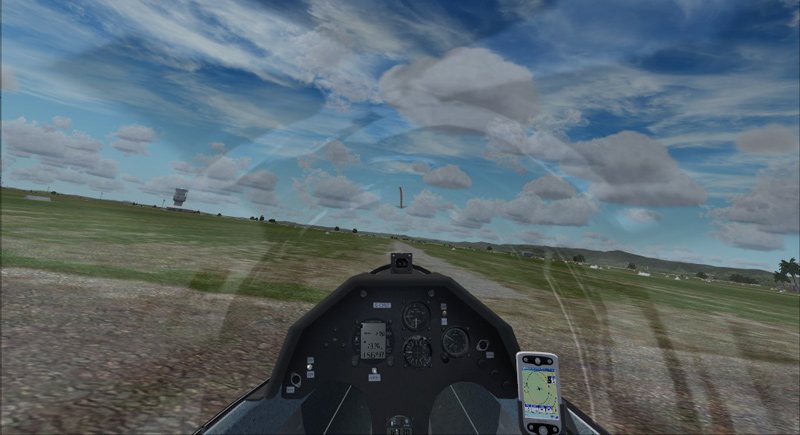 |
If you look to your left and right, you'll see that both wings
have been modelled in great detail. The wings also play host to
a wealth of animations,
such as wing flex, spoilers, and aileron movement. You'll also
notice some nice shadows rendered below both wings.
Of course, because the glider only really has one wheel (it
actually has two, but the one at the back is very small and is
only used to keep the tail off the ground), one wing is tilted
to the ground.
I did, unfortunately, receive a small issue regarding this. The
wing tilted down would bounce up and down quite often,
regardless of if I was on a flat, sloped or rugged runway.
However, there is a fix for this which involves editing the
aircraft.cfg of the Discus Gliders. I applied this small fix and
the bouncing practically stopped altogether.
Winch Launch
As per written above, Aerosoft have included the add-on “WinchX”.
This addon allows for a Winch Launch of Aircraft within FSX (so
is perfect for the Discus Glider X add-on, as it is exclusively
designed for use with gliders such as the Discus).
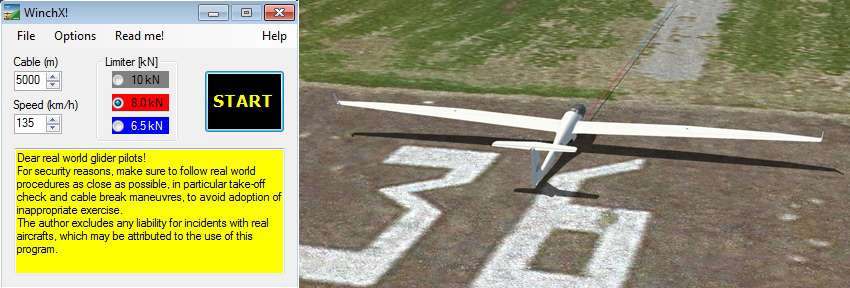 |
WinchX can be viewed as a separate tab, and fires up when FSX is
running.
| Once you have configured the settings (such as cable length,
safety force limiter, etc), hit the Start button. This will
minimise the WinchX program and switch to FSX. The Winch Launch
progress will now start. You'll will hear some nice realistic sounds (in the language of your choice) which co-operate with the animation of the Winch Launch. Sadly, there is a known problem which cannot be fixed with all Winch Launches. The cable of the Winch appears through the cockpit panel. However, Joachim Schweigler of the Aerosoft DG team assured me that this was a problem in which FSX works against the developers, and thus cannot really be cured easily. |
 |
Aircraft Instruments and Systems
As previously mentioned, Aerosoft have designed this add-on to
be completely system intensive. Practically everything that you
see in the real
Discus cockpit has been modelled in this add-on.
I'll split this subsection up into sub-sections of each
individual instrument/system.
Please also note, that Variometers are instruments that are a
common feature of most gliders. They are, simply put, Vertical
Speed Indicators with special features (such as unique
compensations and special readouts). Each Variometer will be
explained in more detail below.
This is quite a large section, but I recommend you read it all
in order to get the best insight into the instruments and
systems Aerosoft have provided.
The C4 Competition
The C4 Competition is a very useful Gliding computer. Aerosoft
have rendered this C4 Competition to almost exacting detail of
the real one.
In fact, Aerosoft are so confident that their C4 Competition is
of real-world accuracy, that they have included the original
real manuals for the C4
Competition.
This seemed like a rather ambitious move to me, so I checked out
the original manuals before using Aerosoft's C4.
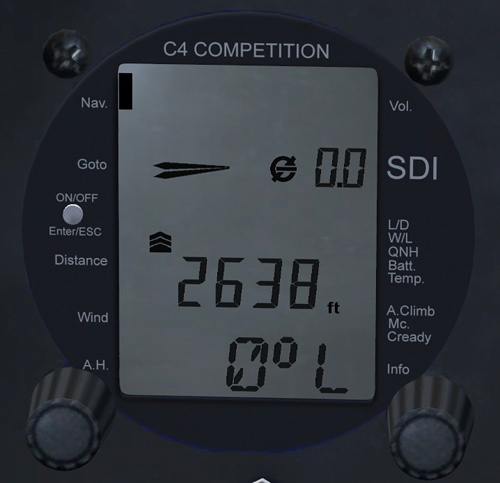
After reading the manual, I started using Aerosoft's C4. To my
amazement, it operated within an extremely narrow margin of how
the manual said it would. I found no problems whatsoever, apart
from the fact that the McCready Ring doesn't appear
to work on Aerosoft's
C4, although after feedback from the developer Joachim
Schweigler,
the C4 does actually have working McCready
settings. The only thing left out is the ring on the analogue
variometer, because the C4 does a far better Job here. It
automatically calculates the speed to fly with McCready value,
and it is fully included from the first version on.
The manual explains in depth both the features and operation of
the C4 Competition. It is vital that you at least have a glance
over the manual before using Aerosoft's model or else you won't
have a clue what's going on.
The thing I really like about Aerosoft's rendition of the C4
Competition is that it really does look like a glass-fronted LCD
display. The screen is crisp, and the screen has a very slight
reflective tint. This isn't just eye candy – This is
professional modelling at its best.
The main “Petal LCD” display of the C4 Competition is a very
useful tool .It acts as both a Variometer (in “Vario” mode), or
a Speed-To-Fly Variometer (in “STF” mode). Both modes work
wonders in FSX, and to really understand them you'll have to
read the manuals (available from Aerosoft's website free of
charge – Even if you don't have the product).
When in Vario mode, the LCD Petal Needle will move up and down,
depending on the air outside. When the needle points upwards,
this is your
cue to slow down (as when the needle points upwards you're in
rising air) to make the most of the thermal. When the needle
points down, it means you are in sinking air and you must do the
opposite.
There are many, many more things that the C4 can do. I simply
can't list them all here, so please do read the manual
(EVERYTHING (except the McCready ring) that is featured in the
manual is featured in Aerosoft's model).
Total Energy Compensated Variometer
The Total Energy Compensated Variometer (TEC Variometer for
short), is a special Variometer which displays the Climb Rate of
the aircraft minus the effects of the input of the pilot.
 |
Whilst a VSI reading is useful, what is even more
important to a Glider Pilot is a reading that tells the
pilot how his aircraft is climbing as if he was making
no input to the controls. This allows the Pilot to see
the “natural” climb of the aircraft. Aerosoft have modelled a fully-working realistic TEC Vario. This instrument makes it much more comfortable for thermalling (The process of finding thermals) than just using the C4 Competition or Netto Variometer (explained later) alone. This Variometer has also been very well coupled with the C4, which provides a matching audio-beep depending on your TEC Climb Rate. This beep is something you'll learn to love in the air as it is your easiest bet to hear if you're in a thermal or not. |
Whilst a VSI reading is useful, what is even more important to a
Glider Pilot is a reading that tells the pilot how his aircraft
is climbing as if he was making no input to the controls. This
allows the Pilot to see the “natural” climb of the aircraft.
Aerosoft have modelled a fully-working realistic TEC Vario. This
instrument makes it much more comfortable for thermalling (the
process of finding thermals) than just using the C4 Competition
or Netto Variometer (explained later) alone.
This Variometer has also been very well coupled with the C4,
which provides a matching audio-beep depending on your TEC Climb
Rate. This beep is something you'll learn to love in the air as
it is your easiest bet to hear if you're in a thermal or not.
Netto Variometer
Aerosoft have also supplied a fully-working “Netto” Variometer.
The Netto Variometer is a Vario much like a TEC Vario, except
for one extra
compensation added. The Netto also takes into account the
intrinsic sink rate of the glider. This all means that one
simple, useful reading is given out – The Netto basically
displays the ascent/descent of the external air.

The Netto Variometer is actually a slave dial driven by the C4
Competition.
Again, the modelling of this gauge is flawless. Not only does
the needle move so smoothly, but it also moves very accurately
and the information that can be obtained from it is very useful
to all Glider Pilots.
Please note the Netto Variometer only appears on the engine
models (the BT and the BM).
Airspeed Indicator
Aerosoft have chosen to depict the real Discus Airspeed
Indicator. This Discus ASI is easy to read, however provides a
whole load of information
such as best climb speed with engine started (only applicable to
the BT and BM models), minimum landing speed at MTOW, and much
more.

This ASI spirals round, displaying your current airspeed. This
is a very important instrument, as if you hit the stall speed
you'll see some very painful results (see flight dynamics
section below).
The ASI is also useful as you need to be going a certain speed
for certain procedures, such as engine start/retraction (for the
BT/BM models), calm air flying, rough air flying, and others.
Again another flawless instrument in this greatly detailed
cockpit.
|
Altimeter |
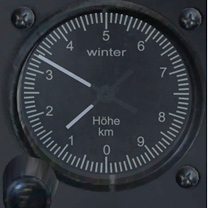 |
Radio
Aerosoft have included an extremely basic radio. It simply has
one simple COM1 function, and has a limited range.
However, Schempp-Hirth didn't feature advanced radios in their
real-world Discus Gliders, so advanced modelling here isn't
really necessary.
Again however, the radio has been custom modelled.
GPS/PDA
This is one feature I really like.
Aerosoft have included a PDA style Global Positioning System
that is common in most gliders. I am really impressed that for
once someone has
scrapped the default GPS and made on of their own. Well done
Aerosoft!

Again due to the vast features of this particular instrument, I
have included Aerosoft's labelled version as shown in their
manual.
This GPS/PDA is great, because it not only looks fabulous, but
it is useful and can aid a pilot in many situations. Such a
situation would be if a pilot was thermalling, and drifted off
course. The pilot can glance at this GPS, and adjust his course
accordingly (as the GPS shows one's flight plan as a solid red
line).
Flight plans can be imported into the GPS automatically if one
is made through FSX. A flight plan made by software such as REX2
could possibly be
imported, but I cannot confirm if this works or not.
The GPS/PDA also has a respective reflection on the canopy,
again a feature that adds to this product's realism and detail.
Unfortunately, when you “remove” the GPS (by clicking a nearby
hotspot), the respective reflection does not get removed on the
canopy (but this is such a small problem it is barely worth
mentioning).
The instrument displays all the important details such as
heading, speed, course (see above). You can also zoom in and out
accordingly.
Another feature I enjoyed with this instrument was the little
bit of eye candy included along the bottom, making it look like
a PDA that runs on Windows Software (again very small but a
feature that made me grin).
Water Ballast System
Discus Gliders have an on-board Water Ballast System. Aerosoft
claim to have modelled a fully working ballast system, and I can
confirm that they
have done so.
In the picture you can see the highlighted liver. This lever
operates the water ballast valve. When it is closed, the water
ballast system remains sealed. Once opened however, you will see
lovely jets of misty water come out the tail of your Glider as
water is ejected from the system.
The Water Ballast System is present to ensure balance in the
Glider.
BT and BM Specific Instruments
Of course, as the BT and BM models have engines, extra
instruments were added that were relative to the engine.
 |
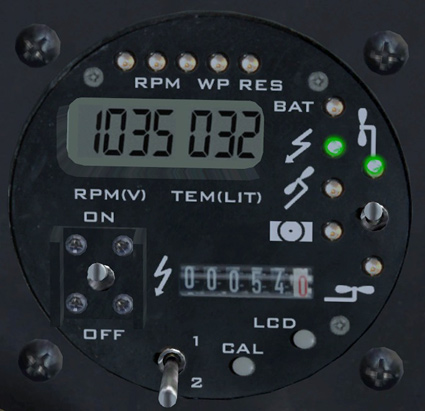 |
|
| BT Engine Instruments | BM Engine Instruments |
One thing I like about these instruments is that the LEDs on
them have a really nice, bright crisp glow to them when lit.
As usual, all switches/needles/etc are 3D modelled and animated
on these panels.
Other Controls
Aerosoft have also modelled most other controls in the cockpit.
Spoiler lever, canopy open switch, throttle (for the BT and BM
models), manual release lever (to released a Winch/Aero-tow
cable from the glider manually), decompression lever (again only
present in the BT and BM engine models), and some others.
All are represented in their real-world positions, and in lovely
HD form.
Modelling
Aerosoft have done a very nice job of modelling the Discus
Gliders both inside and outside the cockpit.
Internal Modelling
This is one place where Aerosoft have outdone other developers.
Not only is everything modelled in 3D (no annoying 2D panels),
but everything (as previously mentioned) is modelled using
high-resolution textures.
Again, scroll towards the top of the review and take another
look at all the cockpits. If you find a single
switch/lever/texture that is not done in high-detail then I owe
you one.
There is also a nice selection of eye candies and animations
inside the cockpit. The microphone, when clicked on, makes a
sound and moves
towards you. This animation is then reversed when next clicked
on.
Practically every control is animated in the cockpit.
The modelling of the ventilation window on the left side of the
canopy is one thing I adore.
As you can see, whilst it is a small part of the cockpit it is
modelling in pure 3D and really gives a feel of something that
is riveted.
The only problem I experienced was when looked down from the
pilots head's point of view. I got a nasty looking piece of
ground poking through the cockpit. Unfortunately, like the
cockpit anomaly, this clipping problem is another FSX shortfall,
even the default DG800 and it is beyond anything the modeller
and do to solve it.
External Modelling
Like the inside, the outside is equally as impressive.
All control surfaces are of course animated, including the trim
tab at the back of the tail. High definition aircraft skin and
other details are present.
On the BT and BM models, the aircraft engine details are really
quite outstanding.
 |
 |
The VC is also expertly modelled from the outside, just take a
look at the details.

Flight Dynamics
One thing that absolutely must be present in a package that
boasts ultimate complexity is flight dynamics.
Aerosoft have tweaked the flight dynamics of their Discus
Gliders to absolute perfection.
The controls feel heavy, just like they should on an aircraft
with such huge wings.
Another piece of gliding skill is a perfect sideslip. A sideslip
is a manoeuvre used mainly in gliders (however it was even used
once in a commercial airliner that had suffered dual engine
failure). A sideslip involves crossing the control surfaces of
an aircraft so that the aircraft “slips” sideways through the
air. Right aileron and left rudder/Left aileron and right rudder
must be applied to achieve a sideslip.
I did look in the Aerosoft package to see if they have correctly
included the ability to perform such a feat – And they have done
so beautifully.
Not only could I perform countless accurate and realistic
side-slips, but I also enjoyed the modelling of a stall.
Once the glider has reached stall speed, you won't just get the
unrealistic FSX default style pitch down stall. You'll get a
real nasty stall, coupled with a deadly spin that requires
experience to get out of.
Aerosoft have also included a yaw-string that some Glider pilots
use. This is a small piece of string that is attached to the
canopy directly above and in front of the pilot's head. It moves
around in the slipstream, telling the pilot how he should be
flying the aircraft.
 |
Other features
Aerosoft have also included a 3D animated pilot modelled both
inside the VC and outside the aircraft.
 |
 |
Dynamic wing flex is represented on each model and is a nice
touch of both realism and detail.
The sounds used in the product are fantastic. From the engine
sounds to the roar of air over the canopy, this is a section on
which Aerosoft must keep up. I want to see these kind of
realistic sounds used in future products too.
Update
After this review was written, Version 1.6 of this add-on was
released. It basically allows you to use a few more of the C4
Competition's functions through keyboard/joystick commands
(instead of actually have to click them on-screen).
This update also tweaks the GOTO Mode of the C4 Competition. Now
the GOTO Mode (the mode which displays AH (Arrival Height) on
the C4) now displays the invaluable calculation of AH to your
net waypoint all the way around the task.
(Simply put, this update allows the much-needed calculation of
the height at which you will arrive at your next waypoint to be
performed all the way)."

![]() Verdict
Verdict
Pros:
– A challenge! This product is unique and nothing like it has
ever been
made before!
– Incredible high-resolution textures and 3D modelling
throughout
– Very realistic instruments and systems
– Flight dynamics spot-on
– CumulusX and WinchX partner this program VERY well
– Awesome sounds
– Animations, eye candies... All work well and are present
throughout
Cons:
– Cable-in-panel issue (although this is more of an FSX issue)
– Wing bouncing issue (although can be cured with some attention
to the
aircraft.cfg)
Overall, I have thoroughly enjoyed my time flying the Discus Gliders.
A very, very well done to Aerosoft – Flawless modelling, great
systems and instruments, unprecedented detail... It has it all.
The add-on is a phenomenal simulation of something completely
new – Glider Flying. Aerosoft are the first company to take on
this task and I must say they have done a remarkable job.
A great challenge for any pilot wishing to expand his
horizons.
Final Score:
My final score will be made by taking the scores from each
relevant individual section, then finding an average of them
all.
– Aircraft Instruments and Systems: 10/10
– Modelling: 9/10 (reduction due to fabulous modelling, but
“through the
ground issue” is annoying)
– Flight Dynamics: 9.5/10 (slight reduction due to wing
bouncing)
– Additional Software required to run the DG add-on:
9.5/10 (WinchX
is
great apart from the cable-in-panel issue)
Overall
9.5/10
![]()
/Jack Whaley-Baldwin
